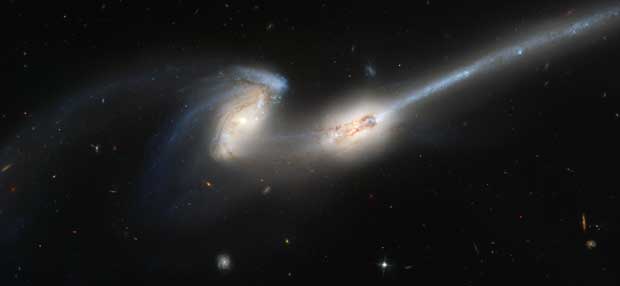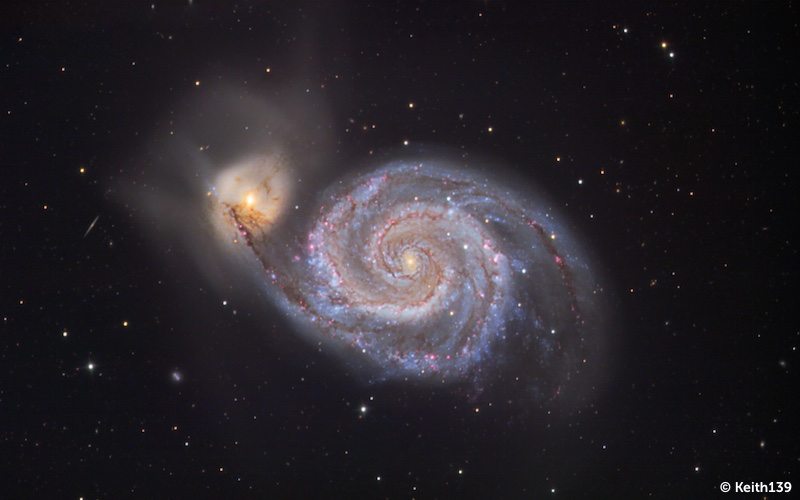As early as 2003, astronomers have presented early evidence of “galactic cannibalism” or a cosmologic phenomenon where a larger galaxy eats one of its smaller neighbors which results in its growth. Recent observations point to the early instances of this merging and cannibalizing phenomenon in the Tucana II ultra-dwarf galaxy.
This galactic phenomenon was reinforced by discoveries of a dark matter halo located in a galaxy 163,000 light years away from Earth. Numerous dwarf galaxies encircle the Milky Way, Tucana II being only one of them. It is one of the most primordial of these relics, which are assumed to be remnants from the very first galaxies in the universe.
Astronomers Puragra GuhaThakurta of UCSC and David Reitzel of UCLA have also detected evidence of galactic cannibalism in Andromeda, a neighboring galaxy to the Milky Way. In their observations, it was found out that Andromeda gobbled up a massive galaxy, named M32p, billions of years ago. In fact, more data are uncovering a 10-billion-year history of galactic cannibalism by sifting through tiny fingerprints in the halo of stars around the Andromeda galaxy.
Data shows that M32p was destroyed by the Andromeda galaxy and was at least 20 times bigger than any galaxy that the Milky Way has ever merged with. After Andromeda and the Milky Way, M32p would have been the biggest galaxy in the Local Group.
Even though M32p was largely destroyed, this gigantic galaxy left behind a wealth of data, including a distinct, puzzling compact galaxy called M32 and an almost imperceptible halo of stars larger than the Andromeda galaxy itself.
It’s been known by scientists for 10 to 15 years that Andromeda has an aggressive history of accumulating and eliminating its neighboring galaxies. Since it’s the closest to our planet, it’s ideal to study how stars have formed around it.
However, even though Andromeda is close to our own galaxy, by galactic standards, it’s still 2.5 million light-years away. Hence, the researchers on galactic merging used the remnants of galactic cannibalism– globular clusters, which are small balls containing tens of thousands or hundreds of thousands of stars and are a frequent component of many galaxies are—as beacons to make measurements of their motions as they orbited the Andromeda galaxy.
The measurements revealed that others orbit in a different way and seem to have come from galaxies that were obliterated a very long time ago—possibly as long as 10 to 12 billion years ago.
But how exactly does galactic cannibalism work? When two galaxies collide, pieces of one are absorbed by the other, a process is known as ‘galactic cannibalism’. . However, this is a two-way activity. The larger galaxy, on the other hand—the one with the stronger gravitational pull—almost always prevails and distorts the smaller galaxy more. Hence, this merging process results in the annihilation of a smaller satellite galaxy and the further growth of the bigger one.
The most typical outcome of galactic cannibalism is an irregular galaxy, though elliptical galaxies can also originate from the gravitational merger of two or more galaxies. Similarly, this process produces new stars as well as altered galaxies. Clouds make up a significant portion of galaxies. Stars are created when cosmic clouds collide.
The Whirlpool Galaxy, the Mice Galaxies, and the Antennae Galaxies, all of which appear to be at one phase or another of merging and cannibalizing, are a few examples of this that have been observed with the aid of the Hubble telescope.
All of this data is consistent in line with the most recent hierarchical models of galaxy formation employed by astronomers, NASA, and other space agencies. According to this theory, galaxies expand by consuming dwarf galaxies and the mini halos of dark matter that surround them.
When satellite galaxies approach the massive halo of the bigger galaxy too closely, some of these dwarf galaxies are destroyed by the gravitational tidal forces. What is left from this merging process is the stream of stars that are left behind as a byproduct of the original explosion.
In fact, our own solar system could be used as an illustration for this event. A disk and a halo make up the Milky Way’s two components. The majority of the young stars in the disk most likely formed in the Milky Way itself. On the other side, the stars in the halo are far older, more primitive stars. The majority of scientists think that these old halo stars were created in nearby galaxies or planetary systems, but were drawn into the Milky Way because of its stronger gravitational attraction.
Now, the question is how ongoing discoveries about galactic cannibalism affect the future of our planet. Studies on galactic cannibalism aid scientists in understanding the future of our region of the universe, including how the Milky Way and Andromeda will interact with other, smaller, neighboring galaxies as well as how, after billions of years, they will finally meet and merge.
Given the Andromeda Galaxy’s vastness and our proximity to it, which boasts over a trillion stars to its meager half a trillion, it seems conceivable that our galaxy will eventually crash with it. Galaxies are far more closely clustered together in many parts of the cosmos. It is only a matter of time before the several enormous moving bodies crash and “devour” one another.
The Andromeda Galaxy is the largest galaxy in the Local Group and it brings with it massive gravitational tide energy. Paul Mason, an astronomer at New Mexico State University in Las Cruces, says that the discovery demonstrates galactic development is a continuing process, not just something that happened at the beginning of the Universe’s existence.
He also claims that it is actually becoming more and more obvious that Andromeda will eventually merge with both the Milky Way and a number of other smaller galaxies, causing our “Local Group” of galaxies to change into fewer larger clusters of galaxies until it finally becomes “a single mega-galaxy.”
And according to him, after around 100 billion years, there is a great scientific probability that we will enter the Virgo Supercluster, which contains numerous galaxy clusters like our own Local Group.


